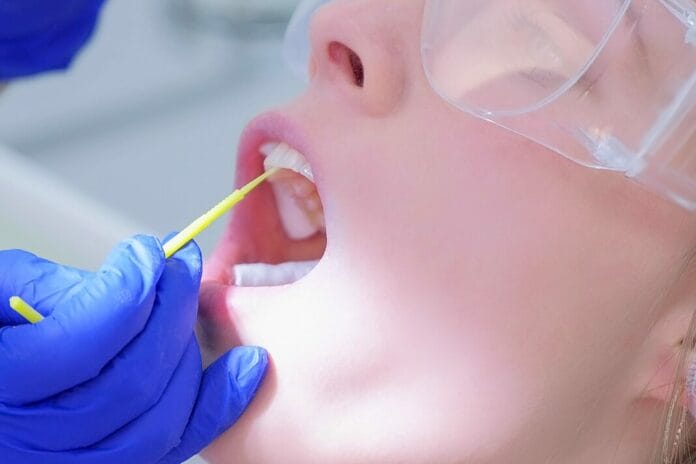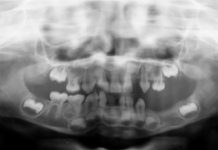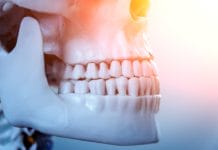Nano-hydroxyapatite varnish has made its way to the market and into some dental practices. Though nano-hydroxyapatite toothpaste has been on the market for several years, nano-hydroxyapatite varnish is a relatively new concept. As with all new products, research and clinical trials are needed to verify safety and efficacy.
An article previously published by Today’s RDH provides insight into nano-hydroxyapatite and micro hydroxyapatite toothpaste, but what do we know about the safety and efficacy of the newly marketed nano-hydroxyapatite varnish?
What We Know
The short answer is not a lot. I couldn’t find any completed clinical trials with study results on nano-hydroxyapatite varnish as a caries prevention agent. However, an ongoing study is evaluating “the cariostatic and remineralizing effects of nano-silver fluoride, nano-hydroxyapatite, and sodium fluoride varnishes in caries prevention,” so we may have some insight soon.1
However, no nano-hydroxyapatite varnishes are listed as “approved” on the U.S. Food and Drug Administration (FDA) website, which leads me to believe this varnish is not FDA-approved. This makes sense because the FDA requires clinical trials before they will approve a drug for use.2
Importance of FDA Approval
FDA approval is important when considering the use of a drug, which is what nano-hydroxyapatite that is being applied in a professional setting and presented as an effective caries prevention treatment would be considered. FDA approval helps with regulation, ensures the product ingredients and quantity of active ingredients are what is claimed by the company, and monitors for any adverse events.3,4
The FDA has removed multiple drugs from the market that are unapproved due to patient harm. For example, quinine sulfate is a drug that was approved to treat a specific type of malaria. However, numerous unapproved quinine sulfate drugs were marketed to relieve leg cramps. Following this marketing campaign, the FDA received 665 adverse event reports, including 93 deaths associated with the use of quinine sulfate.5
This highlights the need for proper safety and efficacy testing and post-market surveillance to protect patients from harm, even with a product as seemingly innocuous as nano-hydroxyapatite varnish.3
Safety Concerns
You may be wondering what possible safety concerns might be associated with nano-hydroxyapatite, considering it is claimed to be “natural” or “biomimetic.” First, I want to clarify that the nano-hydroxyapatite used in toothpaste and, assumingly, in the varnish on the market is synthetic. Synthetic doesn’t automatically mean it is “bad.” However, it can be slightly different than what is found naturally in the body. For instance, the particle shape, size, and aspect ratio have been investigated as a possible safety concern.6,7
With no information available from the FDA, I turned to the Scientific Committee on Consumer Safety (SCCS), which provides opinions on health and safety risks in the European Union (EU).6 In 2015, the SCCS published their opinion on hydroxyapatite (nano) with a revision in 2016.7
In this paper, the SCCS reviewed multiple studies on safety. Some included IV administration, which isn’t something we would do in dentistry; therefore, that information was of no help. However, there were two studies on oral exposure and a few on dermal exposure, which would be a more fitting safety study to consider for the route of exposure in dentistry.7
One of the oral exposure studies was conducted over a three-week evaluation with daily exposure to “needle-shaped” nano-hydroxyapatite. The results indicated that oral administration of needle-shaped nano-hydroxyapatite particles can lead to systemic effects related to hepatoxicity.7
The second oral study did not adhere to the EU guidelines, leaving the results inconclusive. The dermal 28-day study found changes in lipid peroxidation and reduced glutathione. Additionally, histopathology indicated a mild infiltration of mononuclear inflammatory cells. And in the lungs, bronchial-associated lymphoid tissue proliferation was observed.7
Regarding the SCCS conclusion on the toxicokinetics of nano-hydroxyapatite in humans, the opinion paper states, “The available information points to the fact that some forms of nano-hydroxyapatite might exert systemic effects after administration by the dermal and oral route.” Additionally, they found, “From the limited information available it can be supposed, that if systemically available, nano-hydroxyapatite will be distributed to liver, kidneys, and lungs.”7
Nonetheless, their overall findings were inconclusive on the safety. However, they conclude, “The available information indicates that nano-hydroxyapatite in needle-shaped form is of concern in relation to potential toxicity.”7
To be fair, all the studies were conducted in animals, and none of the studies followed the EU guidelines, which contributed to the conclusion that the safety of nano-hydroxyapatite was inconclusive.7
Current European Union Regulations
Though all of the studies reviewed for the opinion paper associated with oral use of products with nano-hydroxyapatite were inconclusive, the SCCS still recommends against the use of “needle-shaped” particles in oral care products.7
The EU provides guidance on the acceptable dose. The regulations state that nano-hydroxyapatite is safe when used at concentrations up to 10% in toothpaste and up to 0.465% in mouthwash. Additionally, for the nano-hydroxyapatite to be considered safe, it must display the following characteristics:7
- Composed of rod-shaped particles, at least 95.8% (in particle number) have an aspect ratio less than 3, and the remaining 4.2% have an aspect ratio not exceeding 4.9.
- The particles must not be coated or surface-modified.
Aspect ratio refers to the surface-to-volume ratio of nanoparticles. Nanomaterials, such as nano-hydroxyapatite, possess a significantly higher surface-to-volume ratio compared to traditional materials, influencing their action mechanisms, distribution within the body, and pharmacokinetics. Their minuscule size gives them unique capabilities, making them highly suitable for various industrial and health care applications.8
Nonetheless, it is crucial to thoroughly investigate the pharmacokinetics, long-term behavior, and potential toxicity of these nanomaterials before they can be safely introduced into clinical settings.8
For the majority of manufactured nanomaterials, in-depth studies akin to traditional pharmacokinetic research conducted for drugs or chemicals are lacking. This is certainly true for nano-hydroxyapatite.8
Based on the current scientific literature, it is imperative to continue assessing the health risks associated with nanomaterial exposure to determine their possible commercial advantages and/or disadvantages.8
Without FDA approval, regulations, and clinical trials, there is no way to definitively know what shape the particles are, the percentage of nano-hydroxyapatite, or the aspect ratio used in a product. Companies can make claims about these aspects, but no one is regulating them to ensure the claims are true.5
Efficacy Concerns
There is very little published research assessing the efficacy of nano-hydroxyapatite for caries prevention. The literature that is published is of poor quality and at high risk of bias. A systematic review and meta-analysis found 16 in vivo and seven in situ studies that met the criteria for the review.9
Of those, two were eliminated due to no control group, five were eliminated due to limited study duration, three due to being ex vivo, one due to a lack of an Institutional Review Board (IRB) approval report, and two due to being a registered study without published results. This left a total of 10 studies that were included in the systematic review.9
All in vivo studies were determined to be inconclusive due to study designs not reflecting everyday conditions. The meta-analysis from the in-situ studies determined that nano-hydroxyapatite “may not hinder enamel demineralization, but it might be a viable option to remineralize enamel caries, albeit only when remineralization conditions are already present.”9
Additionally, nano-hydroxyapatite does not improve resistance to demineralization in the same manner as fluoride. When fluoride is incorporated into the tooth structure as fluorapatite, the critical pH is 4.5, compared to a critical pH of 5.5 for hydroxyapatite. Therefore, in the long term, fluoride is a better choice for reducing the risk of demineralization associated with acid-producing bacteria.10
In summary, the current evidence on efficacy shows:9,10
- Clinical research on nano-hydroxyapatite as a caries prevention agent is scarce, and there is no published clinical research on nano-hydroxyapatite varnish.
- Nano-hydroxyapatite can remineralize enamel when laboratory conditions favor remineralization. There is no clear evidence of the efficacy in vivo.
- Nano-hydroxyapatite is not as good as fluoride for remineralization in conditions that favor demineralization. High caries risk patients may not benefit from nano-hydroxyapatite. However, it may be a reasonable option for patients at low risk of developing caries.
- Nano-hydroxyapatite does not improve resistance to demineralization in the long term. Fluoride is still the better option for long-term resistance to demineralization.
What One Company Had to Say
It is only fair to get feedback from at least one company that sells nano-hydroxyapatite varnish. I reached out to them to gather more information. In my email, I asked two questions:
- Is your product FDA-approved?
- Can you provide me with the clinical trial ID that shows the data on safety and efficacy in the prevention of dental caries?
This was their response:
Hi! Thanks for getting in touch with the [company name] Support Team. We will review your request and be in touch with you within 24 hours during business days (Monday – Friday).
I received this response on Wednesday, February 14, 2024, at 7:32 am. Fast forward four weeks later, and I’ve received no further correspondence.
This further gives me pause about the use of their product in a professional capacity. If I had the evidence to back my product, I would be quick to respond and provide the evidence to a potential customer. Unfortunately, the lack of response leads me to believe there is a lack of evidence.
Conclusion
Health care, including dentistry, is an evidence-based profession. Our patients depend on us to use treatment modalities and products that have been proven safe and effective. We have an ethical duty to do so.
Currently, there is not enough evidence to show that nano-hydroxyapatite in any form prevents caries, with zero evidence for varnish. This makes me concerned by the lack of independent, peer-reviewed scientific studies verifying these claims. In no way does this mean that it won’t be found to be an effective alternative to other caries prevention agents in the future. However, it is important to wait for clinical studies to determine its efficacy and safety.
I urge caution when recommending and charging patients for nano-hydroxyapatite varnish application under the guise that it is as effective as fluoride at preventing caries because of the lack of clinical trials on safety and efficacy. If you want to use it, I urge you to be transparent about the lack of clinical research to back it as an effective caries prevention agent as well as the lack of safety studies. If the patient decides they still want to move forward with the treatment and pay for it, that becomes their decision. However, without the proper information, the patient cannot make an informed decision regarding their treatment options.
I understand patients want options other than fluoride, but lack of transparency is not the way to provide this. I also understand some hygienists are very excited about the idea of nano-hydroxyapatite as an alternative to fluoride, and this information may not be received well by some. However, I have no intention of pleasing the masses, only providing the information and science as it becomes available. Currently, the science does not support the use of nano-hydroxyapatite varnish as a caries prevention agent.
Before you leave, check out the Today’s RDH self-study CE courses. All courses are peer-reviewed and non-sponsored to focus solely on high-quality education. Click here now.
Listen to the Today’s RDH Dental Hygiene Podcast Below:
References
- Cariostatic and Remineralizing Effects of Three Different Dental Varnishes [ClinicalTrials.gov ID: NCT04887389]. (2022, June 8). NIH: National Library of Medicine, National Center for Biotechnology Information. https://clinicaltrials.gov/study/NCT04887389
- The Device Development Process. (2018, January 4). U.S. Food and Drug Administration. https://www.fda.gov/patients/learn-about-drug-and-device-approvals/device-development-process
- The FDA’s Drug Review Process: Ensuring Drugs Are Safe and Effective. (2017, November 24). U.S. Food and Drug Administration. https://www.fda.gov/drugs/information-consumers-and-patients-drugs/fdas-drug-review-process-ensuring-drugs-are-safe-and-effective
- Step 5: FDA Post-Market Drug Safety Monitoring. (2018, January 4). U.S. Food and Drug Administration. https://www.fda.gov/patients/drug-development-process/step-5-fda-post-market-drug-safety-monitoring
- Unapproved Drugs and Patient Harm. (2021, June 2). U.S. Food and Drug Administration. https://www.fda.gov/drugs/enforcement-activities-fda/unapproved-drugs-and-patient-harm
- Scientific Committee on Consumer Safety (SCCS). (n.d.). European Commission. https://health.ec.europa.eu/scientific-committees/scientific-committee-consumer-safety-sccs_en
- Scientific Committee on Consumer Safety. (2016, March 16). Opinion on Hydroxyapatite (Nano). European Commission. https://ec.europa.eu/health/scientific_committees/consumer_safety/docs/sccs_o_191.pdf
- Gupta, P. K. (2016). Toxicology Testing: Genesis. In P. K. Gupta, Fundamentals of Toxicology: Essential Concepts and Applications (pp. 111- 122). Academic Press.
- Wierichs, R.J., Wolf, T.G., Campus, G., Carvalho, T.S. Efficacy of Nano-Hydroxyapatite on Caries Prevention – A Systematic Review and Meta-Analysis. Clinical Oral Investigations. 2022; 26(4): 3373-3381. https://doi.org/10.1007/s00784-022-04390-4
- Epple, M., Enax, J., Meyer, F. Prevention of Caries and Dental Erosion by Fluorides – A Critical Discussion Based on Physico-Chemical Data and Principles. Dentistry Journal. 2022; 10(1): 6. https://doi.org/10.3390/dj10010006












